An Overview of Aplysinopsins: Synthesis and Biological Activities
Abstract
1. Introduction
2. Different Sources and Chemical Structures of Aplysinopsins
3. Synthesis
4. Aplysinopsins Analogs
5. Biological Activity
6. Conclusions
Author Contributions
Funding
Acknowledgments
Conflicts of Interest
References
- Karthikeyan, A.; Joseph, A.; Nair, B.G. Promising bioactive compounds from the marine environment and their potential effects on various diseases. J. Genet. Eng. Biotechnol. 2022, 20, 14. [Google Scholar] [CrossRef] [PubMed]
- Bialonska, D.; Zjawiony, J.K. Aplysinopsins—Marine Indole Alkaloids: Chemistry, Bioactivity and Ecological Significance. Mar. Drugs 2009, 7, 166. [Google Scholar] [CrossRef] [PubMed][Green Version]
- Kazlauskas, R.; Murphy, P.T.; Quinn, R.J.; Wells, R.J. Aplysinopsin, a new tryptophan derivative from a sponge. Tetrahedron Lett. 1977, 18, 61–64. [Google Scholar] [CrossRef]
- Kh, H.; Fj, S. Aplysinopsin: Antineoplastic Tryptophan Derivative from the Marine Sponge Verongia Spengelii. Lloydia 1977, 40, 479–481. [Google Scholar]
- Djura, P.; Faulkner, D.J. Metabolites of the marine sponge Dercitus species. J. Org. Chem. 1980, 45, 735–737. [Google Scholar] [CrossRef]
- Aoki, S.; Ye, Y.; Higuchi, K.; Takashima, A.; Tanaka, Y.; Kitagawa, I.; Kobayashi, M. Novel Neuronal Nitric Oxide Synthase (nNOS) Selective Inhibitor, Aplysinopsin-Type Indole Alkaloid, from Marine Sponge Hyrtios erecta. Chem. Pharm. Bull. 2001, 49, 1372–1374. [Google Scholar] [CrossRef] [PubMed][Green Version]
- Hu, J.-F.; Schetz, J.A.; Kelly, M.; Peng, J.-N.; Ang, K.K.H.; Flotow, H.; Leong, C.Y.; Ng, S.B.; Buss, A.D.; Wilkins, S.P.; et al. New Antiinfective and Human 5-HT2 Receptor Binding Natural and Semisynthetic Compounds from the Jamaican Sponge Smenospongia aurea. J. Nat. Prod. 2002, 65, 476–480. [Google Scholar] [CrossRef]
- Segraves, N.L.; Crews, P. Investigation of Brominated Tryptophan Alkaloids from Two Thorectidae Sponges: Thorectandra and Smenospongia. J. Nat. Prod. 2005, 68, 1484–1488. [Google Scholar] [CrossRef]
- Kochanowska, A.J.; Rao, K.V.; Childress, S.; El-Alfy, A.; Matsumoto, R.R.; Kelly, M.; Stewart, G.S.; Sufka, K.J.; Hamann, M.T. Secondary Metabolites from Three Florida Sponges with Antidepressant Activity. J. Nat. Prod. 2008, 71, 186–189. [Google Scholar] [CrossRef][Green Version]
- Okuda, R.K.; Klein, D.; Kinnel, R.B.; Li, M.; Scheuer, P.J. Marine natural products: The past twenty years and beyond. Pure Appl. Chem. 1982, 54, 1907–1914. [Google Scholar] [CrossRef][Green Version]
- Fusetani, N.; Asano, M.; Matsunaga, S.; Hashimoto, K. Bioactive marine metabolites—XV. Isolation of aplysinopsin from the Scleractinian coral Tubastrea aurea as an inhibitor of development of fertilized sea urchin eggs. Comp. Biochem. Physiol. Part B Comp. Biochem. 1986, 85, 845–846. [Google Scholar] [CrossRef]
- Guella, G.; Mancini, I.; Zibrowius, H.; Pietra, F. Novel Aplysinopsin-Type Alkaloids from Scleractinian Corals of the Family Dendrophylliidae of the Mediterranean and the Philippines. Configurational-assignment criteria, stereospecific synthesis, and photoisomerization. Helvetica Chim. Acta 1988, 71, 773–782. [Google Scholar] [CrossRef]
- Koh, E.G.; Sweatman, H. Chemical warfare among scleractinians: Bioactive natural products from Tubastraea faulkneri Wells kill larvae of potential competitors. J. Exp. Mar. Biol. Ecol. 2000, 251, 141–160. [Google Scholar] [CrossRef] [PubMed]
- Iwagawa, T.; Miyazaki, M.; Okamura, H.; Nakatani, M.; Doe, M.; Takemura, K. Three novel bis(indole) alkaloids from a stony coral, Tubastraea sp. Tetrahedron Lett. 2003, 44, 2533–2535. [Google Scholar] [CrossRef]
- Jaromin, A.; Czopek, A.; Parapini, S.; Basilico, N.; Misiak, E.; Gubernator, J.; Zagórska, A. Synthesis and Antiplasmodial Activity of Novel Bioinspired Imidazolidinedione Derivatives. Biomolecules 2021, 11, 33. [Google Scholar] [CrossRef] [PubMed]
- Campos, P.-E.; Pichon, E.; Moriou, C.; Clerc, P.; Trépos, R.; Frederich, M.; De Voogd, N.; Hellio, C.; Gauvin-Bialecki, A.; Al-Mourabit, A. New Antimalarial and Antimicrobial Tryptamine Derivatives from the Marine Sponge Fascaplysinopsis reticulata. Mar. Drugs 2019, 17, 167. [Google Scholar] [CrossRef] [PubMed][Green Version]
- Almeida, M.C.; Resende, D.I.S.P.; da Costa, P.M.; Pinto, M.M.M.; Sousa, E. Tryptophan derived natural marine alkaloids and synthetic derivatives as promising antimicrobial agents. Eur. J. Med. Chem. 2020, 209, 112945. [Google Scholar] [CrossRef]
- Hong, A.; Tu, L.C.; Yang, I.; Lim, K.-M.; Nam, S.-J. Marine natural products with monoamine oxidase (MAO) inhibitory activity. Pharm. Biol. 2020, 58, 716–720. [Google Scholar] [CrossRef]
- Lewellyn, K.; Bialonska, D.; Loria, M.J.; White, S.W.; Sufka, K.J.; Zjawiony, J.K. In vitro structure–activity relationships of aplysinopsin analogs and their in vivo evaluation in the chick anxiety–depression model. Bioorganic Med. Chem. 2013, 21, 7083–7090. [Google Scholar] [CrossRef]
- Serkedjieva, J.; Konaklieva, M.; Dimitrova-Konaklieva, S.; Ivanova, V.; Stefanov, K.; Popov, S. Antiinfluenza Virus Effect of Extracts from Marine Algae and Invertebrates. Z. Naturforschung. C J. Biosci. 2000, 55, 87–93. [Google Scholar] [CrossRef]
- Nuthakki, V.K.; Yadav Bheemanaboina, R.R.; Bharate, S.B. Identification of aplysinopsin as a blood-brain barrier permeable scaffold for anti-cholinesterase and anti-BACE-1 activity. Bioorganic Chem. 2021, 107, 104568. [Google Scholar] [CrossRef] [PubMed]
- Penthala, N.R.; Yerramreddy, T.R.; Crooks, P.A. Synthesis and in vitro screening of novel N-benzyl aplysinopsin analogs as potential anticancer agents. Bioorganic Med. Chem. Lett. 2011, 21, 1411–1413. [Google Scholar] [CrossRef][Green Version]
- Thirupathi Reddy, Y.; Narsimha Reddy, P.; Koduru, S.; Damodaran, C.; Crooks, P.A. Aplysinopsin analogs: Synthesis and anti-proliferative activity of substituted (Z)-5-(N-benzylindol-3-ylmethylene)imidazolidine-2,4-diones. Bioorganic Med. Chem. 2010, 18, 3570–3574. [Google Scholar] [CrossRef] [PubMed][Green Version]
- Tymiak, A.A.; Rinehart, K.L.; Bakus, G.J. Constituents of morphologically similar sponges: Aplysina and Smenospongia Species. Tetrahedron 1985, 41, 1039–1047. [Google Scholar] [CrossRef]
- Fattorusso, E.; Lanzotti, V.; Magno, S.; Novellino, E. Tryptophan Derivatives from a Mediterranean Anthozoan, Astroides calycularis. J. Nat. Prod. 1985, 48, 924–927. [Google Scholar] [CrossRef]
- Murata, M.; Miyagawa-Kohshima, K.; Nakanishi, K.; Naya, Y. Characterization of Compounds That Induce Symbiosis Between Sea Anemone and Anemone Fish. Science 1986, 234, 585–587. [Google Scholar] [CrossRef] [PubMed]
- Kondo, K.; Nishi, J.; Ishibashi, M.; Kobayashi, J. Two New Tryptophan-Derived Alkaloids from the Okinawan Marine Sponge Aplysina sp. J. Nat. Prod. 1994, 57, 1008–1011. [Google Scholar] [CrossRef] [PubMed]
- Djura, P.; Stierle, D.B.; Sullivan, B.; Faulkner, D.J.; Arnold, E.V.; Clardy, J. Some metabolites of the marine sponges Smenospongia aurea and Smenospongia (Ident.Polyfibrospongia) echina. J. Org. Chem. 1980, 45, 1435–1441. [Google Scholar] [CrossRef]
- Mancini, I.; Guella, G.; Zibrowius, H.; Pietra, F. On the origin of quasi-racemic aplysinopsin cycloadducts, (bis)indole alkaloids isolated from scleractinian corals of the family Dendrophylliidae. Involvement of enantiodefective Diels–Alderases or asymmetric induction in artifact processes involving adventitious catalysts? Tetrahedron 2003, 59, 8757–8762. [Google Scholar] [CrossRef]
- Meyer, M.; Delberghe, F.; Liron, F.; Guillaume, M.; Valentin, A.; Guyot, M. An antiplasmodial new (bis)indole alkaloid from the hard coral Tubastraea sp. Nat. Prod. Res. 2009, 23, 178–182. [Google Scholar] [CrossRef]
- Balansa, W.; Islam, R.; Gilbert, D.F.; Fontaine, F.; Xiao, X.; Zhang, H.; Piggott, A.M.; Lynch, J.W.; Capon, R.J. Australian marine sponge alkaloids as a new class of glycine-gated chloride channel receptor modulator. Bioorganic Med. Chem. 2013, 21, 4420–4425. [Google Scholar] [CrossRef] [PubMed]
- Iwagawa, T.; Miyazaki, M.; Yokogawa, Y.; Okamura, H.; Nakatani, M.; Doe, M.; Morimoto, Y.; Takemura, K. Aplysinopsin Dimers from a Stony Coral. Tubastraea aurea. Heterocycles 2008, 75, 2023. [Google Scholar] [CrossRef]
- Dai, J.; Jiménez, J.I.; Kelly, M.; Barnes, S.; Lorenzo, P.; Williams, P. Dictazolines A and B, Bisspiroimidazolidinones from the Marine Sponge Smenospongia cerebriformis. J. Nat. Prod. 2008, 71, 1287–1290. [Google Scholar] [CrossRef][Green Version]
- Dai, J.; Jiménez, J.I.; Kelly, M.; Williams, P.G. Dictazoles: Potential Vinyl Cyclobutane Biosynthetic Precursors to the Dictazolines. J. Org. Chem. 2010, 75, 2399–2402. [Google Scholar] [CrossRef] [PubMed][Green Version]
- Song, S.; Kim, S.; El-Sawy, E.R.; Cerella, C.; Orlikova-Boyer, B.; Kirsch, G.; Christov, C.; Dicato, M.; Diederich, M. Anti-Leukemic Properties of Aplysinopsin Derivative EE-84 Alone and Combined to BH3 Mimetic A-1210477. Mar. Drugs 2021, 19, 285. [Google Scholar] [CrossRef]
- Molina, P.; Fresneda, P.M.; Almendros, P. A simple and general entry to Aplysinopsine-type alkaloids by tandem Aza-Wittig/heterocumulene-mediated annelation. Tetrahedron Lett. 1992, 33, 4491–4494. [Google Scholar] [CrossRef]
- Dalkafouki, A.; Ardisson, J.; Kunesch, N.; Lacombe, L.; Poisson, J.E. Synthesis of 2-dimethylaminoimidazole derivatives: A new access to indolyl-imidazole alkaloids of marine origin. Tetrahedron Lett. 1991, 32, 5325–5328. [Google Scholar] [CrossRef]
- Skiredj, A.; Beniddir, M.A.; Joseph, D.; Leblanc, K.; Bernadat, G.; Evanno, L.; Poupon, E. Spontaneous Biomimetic Formation of (±)-Dictazole B under Irradiation with Artificial Sunlight. Angew. Chem. Int. Ed. 2014, 53, 6419–6424. [Google Scholar] [CrossRef]
- Skiredj, A.; Beniddir, M.; Joseph, D.; Leblanc, K.; Bernadat, G.; Evanno, L.; Poupon, E. A Unified Bioinspired “Aplysinopsin Cascade”: Total Synthesis of (±)-Tubastrindole B and Related Biosynthetic Congeners. Org. Lett. 2014, 16, 4980–4983. [Google Scholar] [CrossRef]
- Skiredj, A.; Beniddir, M.A.; Joseph, D.; Bernadat, G.; Evanno, L.; Poupon, E. Harnessing the Intrinsic Reactivity within the Aplysinopsin Series for the Synthesis of Intricate Dimers: Natural from Start to Finish. Synthesis 2015, 47, 2367–2376. [Google Scholar] [CrossRef]
- Duchemin, N.; Skiredj, A.; Mansot, J.; Leblanc, K.; Vasseur, J.-J.; Beniddir, M.A.; Evanno, L.; Poupon, E.; Smietana, M.; Arseniyadis, S. DNA-Templated [2 + 2] Photocycloaddition: A Straightforward Entry into the Aplysinopsin Family of Natural Products. Angew. Chem. 2018, 130, 11960–11965. [Google Scholar] [CrossRef]
- Johnson, J.E.; Canseco, D.C.; Dolliver, D.D.; Schetz, J.A.; Fronczek, F.R. Synthesis and Characterization of Aplysinopsin Analogs. J. Chem. Crystallogr. 2009, 39, 329–336. [Google Scholar] [CrossRef]
- Cummings, D.F.; Canseco, D.C.; Sheth, P.; Johnson, J.E.; Schetz, J.A. Synthesis and structure–affinity relationships of novel small molecule natural product derivatives capable of discriminating between serotonin 5-HT1A, 5-HT2A, 5-HT2C receptor subtypes. Bioorganic Med. Chem. 2010, 18, 4783–4792. [Google Scholar] [CrossRef] [PubMed][Green Version]
- Jakše, R.; Bevk, D.; Golobič, A.; Svete, J.; Stanovnik, B. Synthesis and Transformations of Ethyl 3-Formyl-1H-indole-2-carboxylate. Preparation of Aplysinopsin and β-Carboline Thiohydantoin Analogues. Z. Nat. B 2006, 61, 413–419. [Google Scholar] [CrossRef][Green Version]
- Suzdalev, K.F.; Babakova, M.N. Synthesis of Analogues of Indole Alkaloids from Sea Sponges—Aplysinopsins by the Reaction of Amines with (4Z)-4-[(1H-indol-3-yl)-methylene]-1,3-oxazol-5(4H)-ones. J. Heterocycl. Chem. 2016, 53, 1200–1206. [Google Scholar] [CrossRef]
- El-Sawy, E.R.; El-Shahid, Z.A.; Soliman, A.A.F.; Nassrallah, A.; Abdelwahab, A.B.; Kirsch, G.; Abdelmegeed, H. Synthetic Analogs of Marine Alkaloid Aplysinopsin Suppress Anti-Apoptotic Protein BCL2 in Prostate Cancer. Molecules 2023, 28, 109. [Google Scholar] [CrossRef]
- Nuthakki, V.K.; Sharma, A.; Kumar, A.; Bharate, S.B. Identification of embelin, a 3-undecyl-1,4-benzoquinone from Embelia ribes as a multitargeted anti-Alzheimer agent. Drug Dev. Res. 2019, 80, 655–665. [Google Scholar] [CrossRef]
- Passemar, C.; Saléry, M.; Soh, P.N.; Linas, M.-D.; Ahond, A.; Poupat, C.; Benoit-Vical, F. Indole and aminoimidazole moieties appear as key structural units in antiplasmodial molecules. Phytomedicine 2011, 18, 1118–1125. [Google Scholar] [CrossRef]
- Wells, R.J.; Murphy, P.T. 5-(Indol-3-Ylmethylene)-1,3-Dimethyl-2-Methylamino-4-Imidazolidinone. U.S. Patent US4195179A, 25 March 1980. [Google Scholar]
- Baird-Lambert, J.; Davis, P.A.; Taylor, K.M. Methylaplysinopsin: A natural product of marine origin with effects on serotonergic neurotransmission. Clin. Exp. Pharmacol. Physiol. 1982, 9, 203–212. [Google Scholar] [CrossRef]
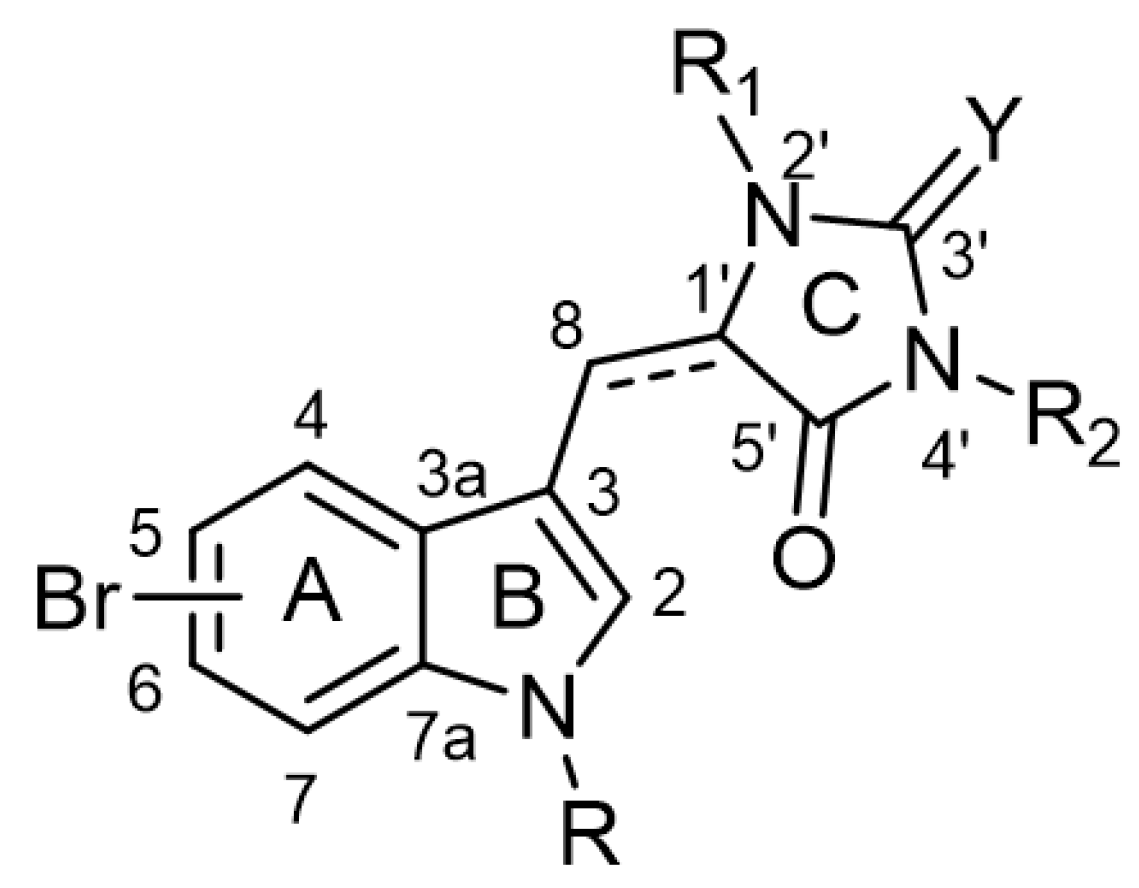

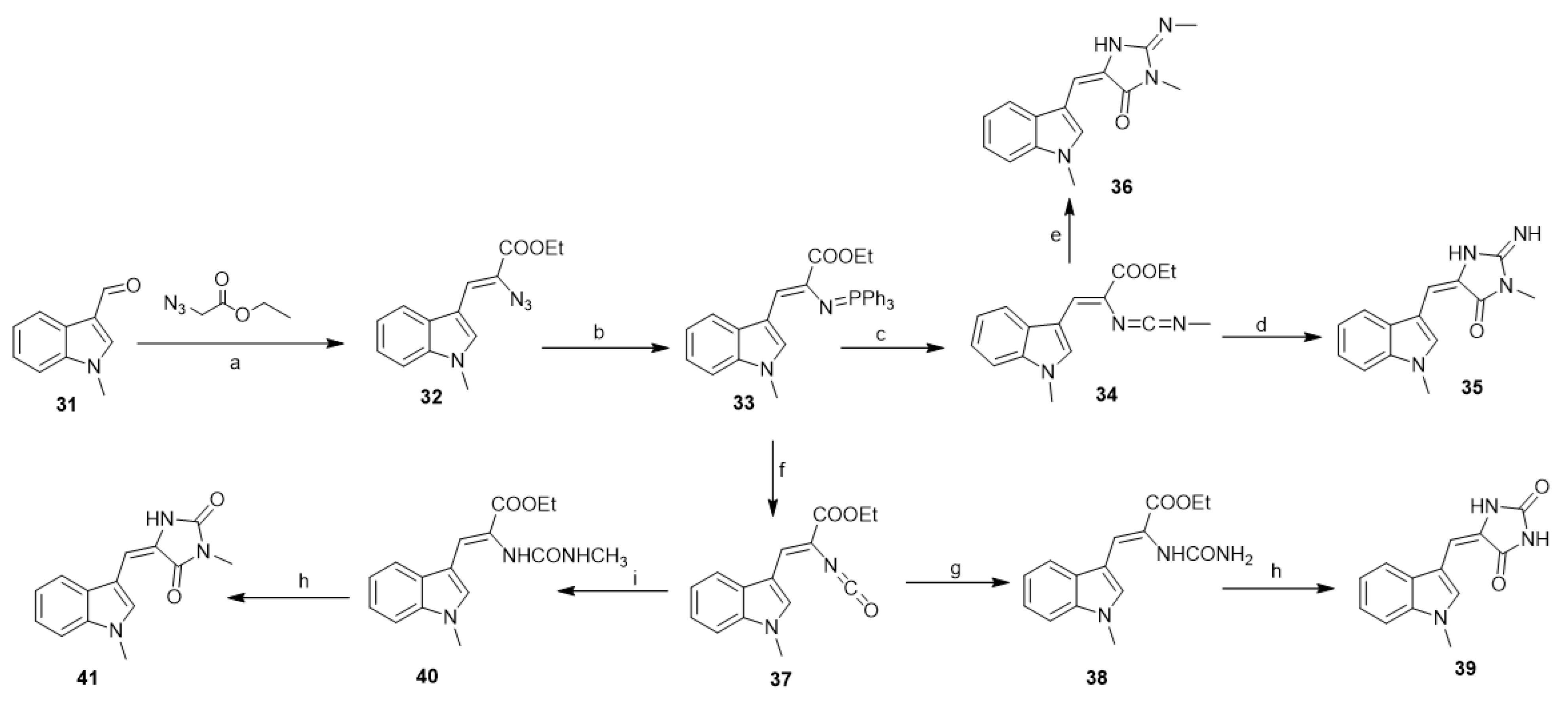
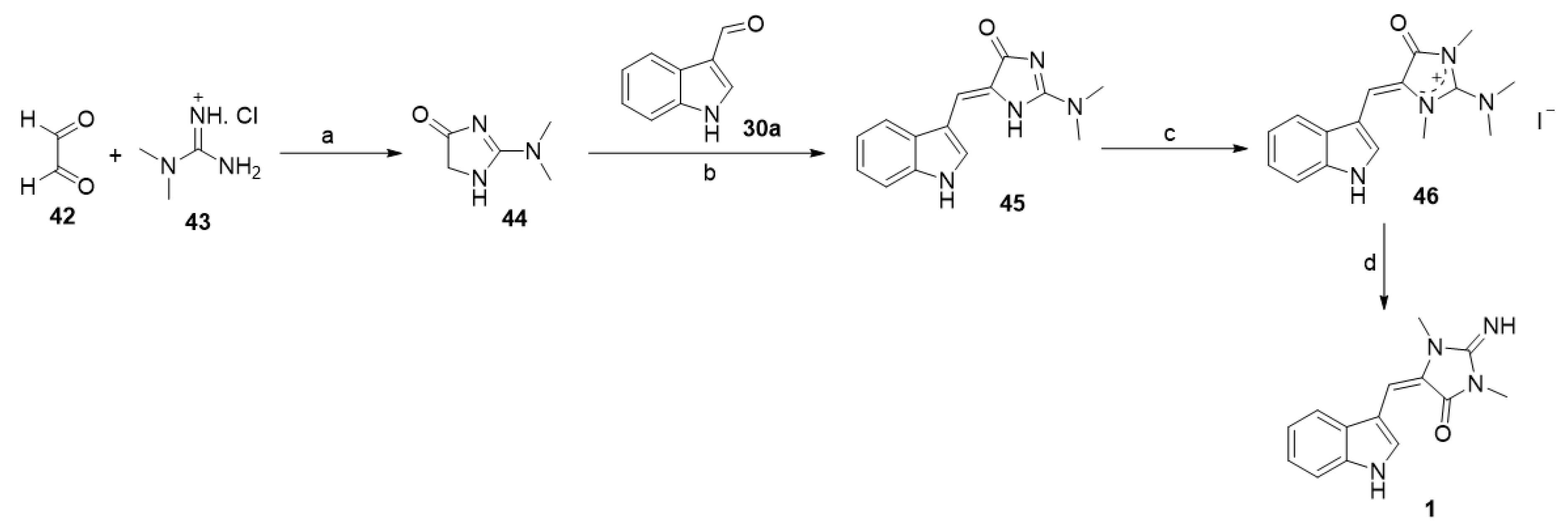

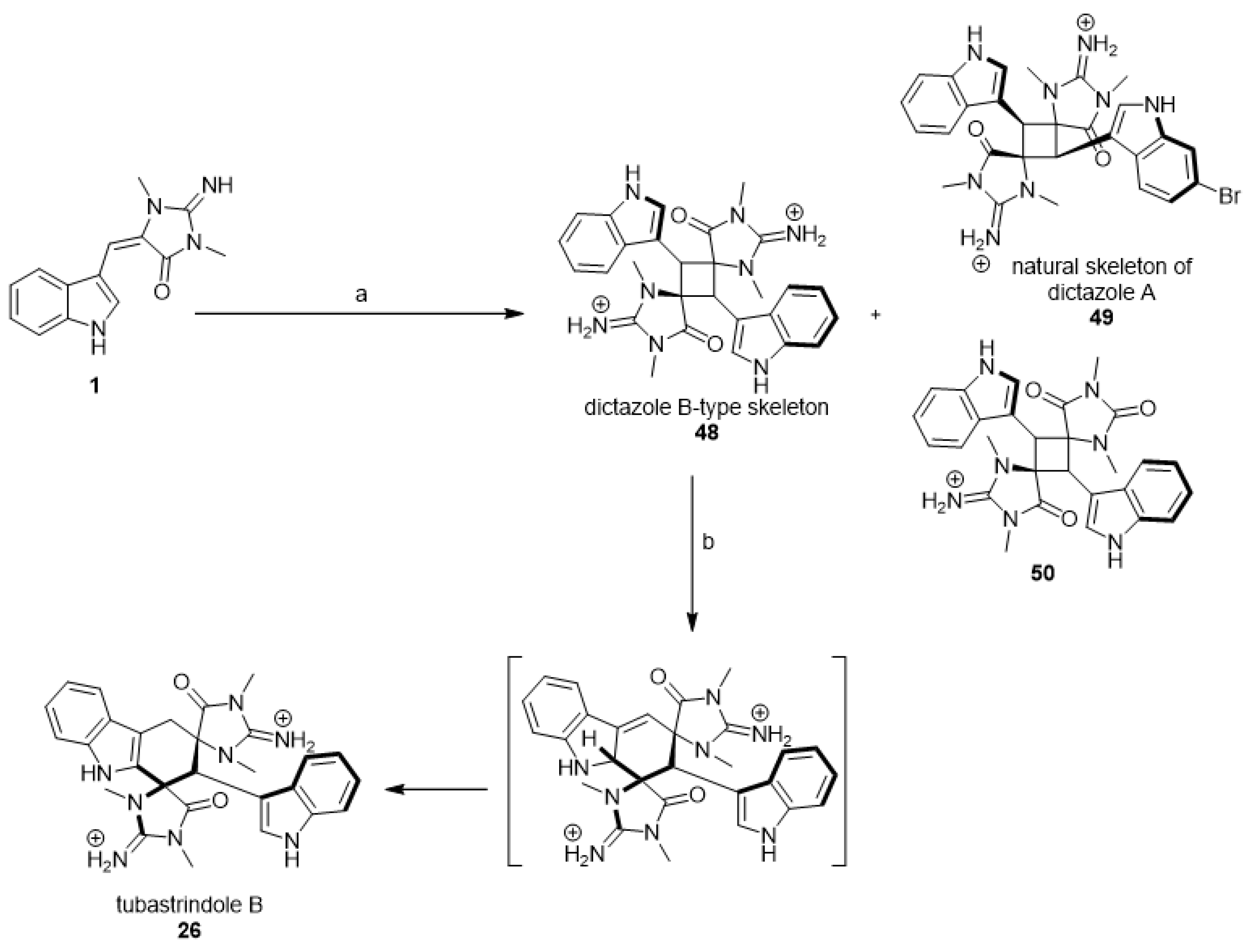
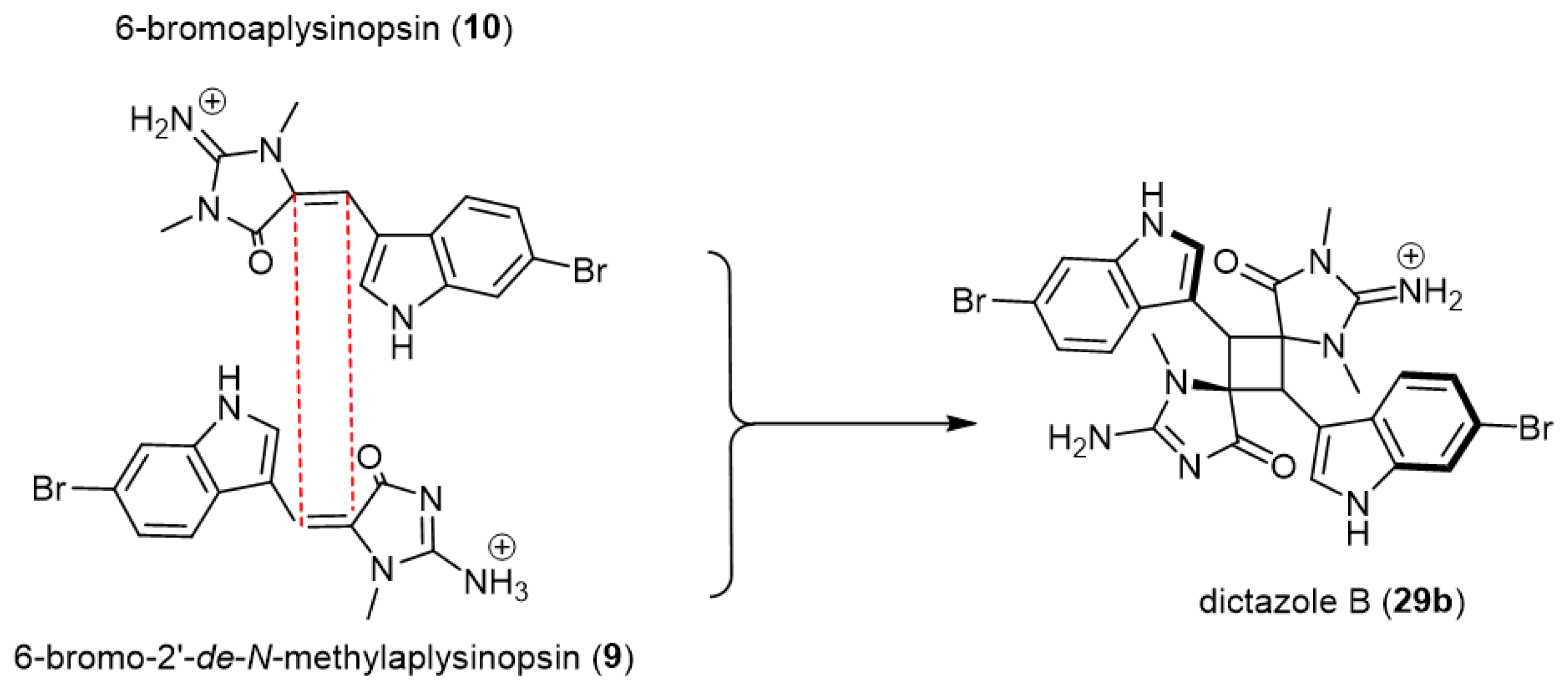
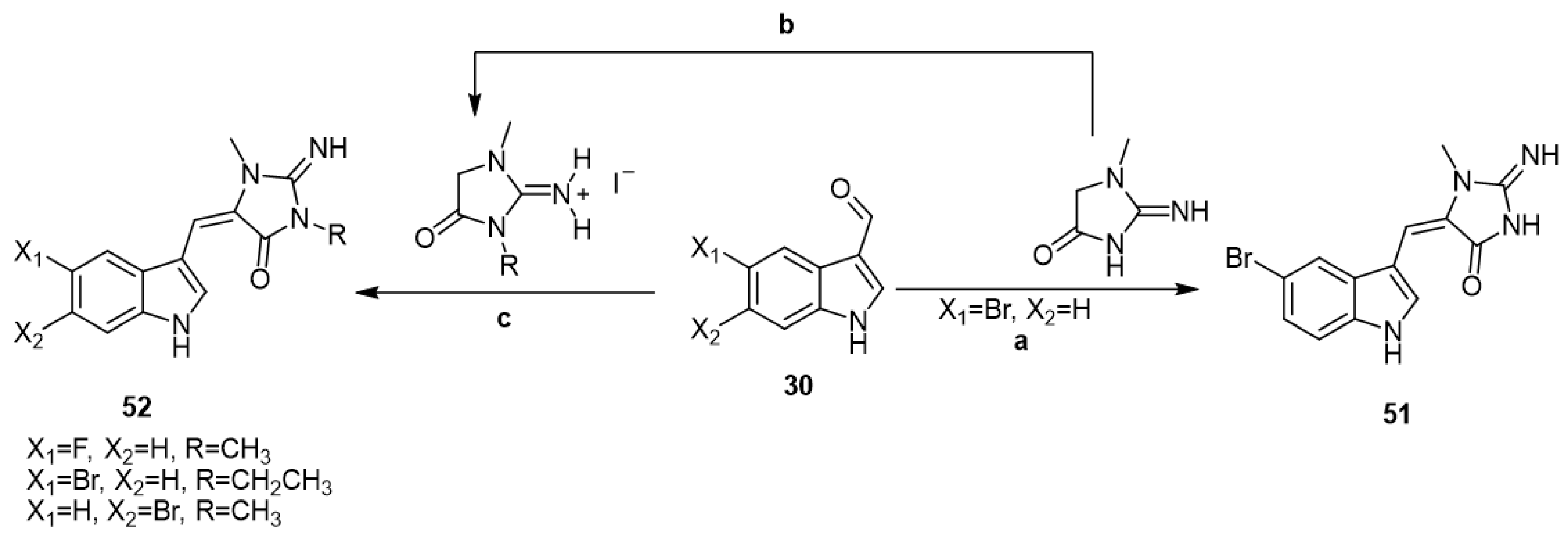

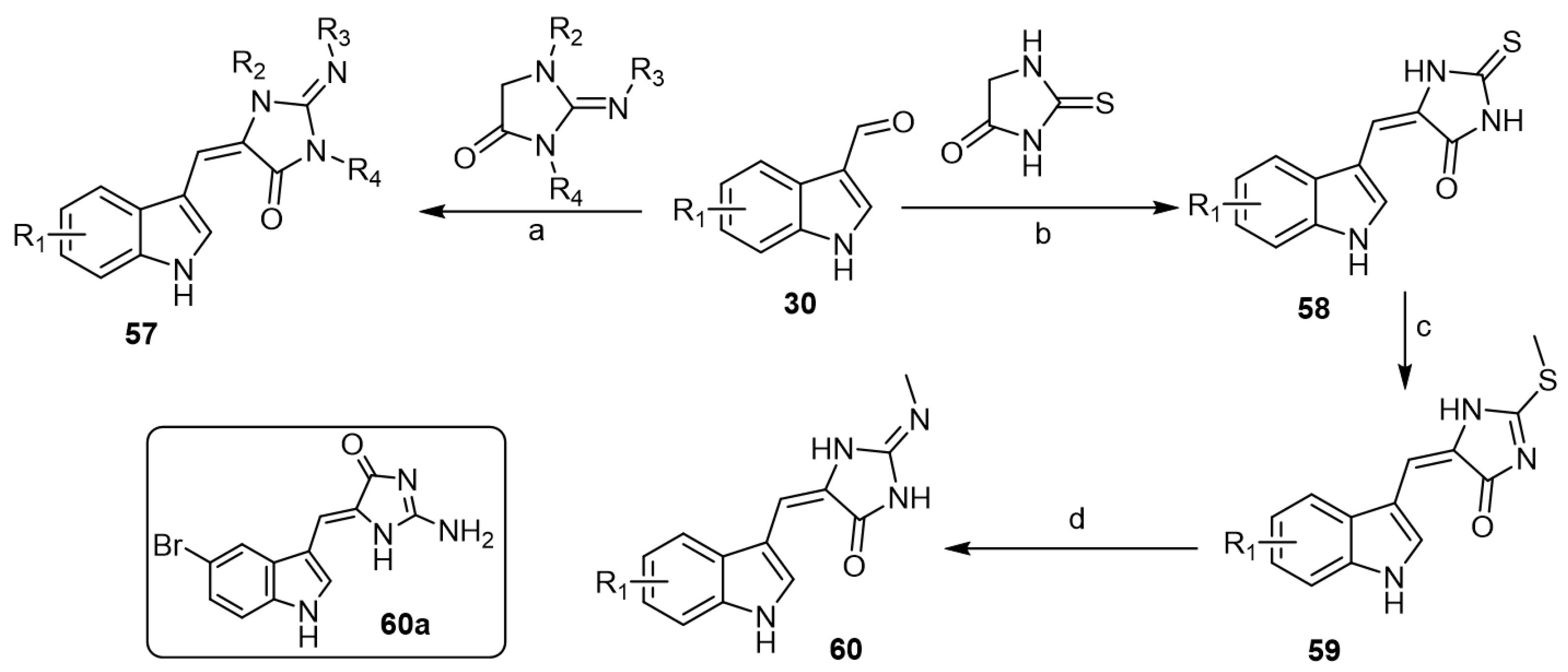
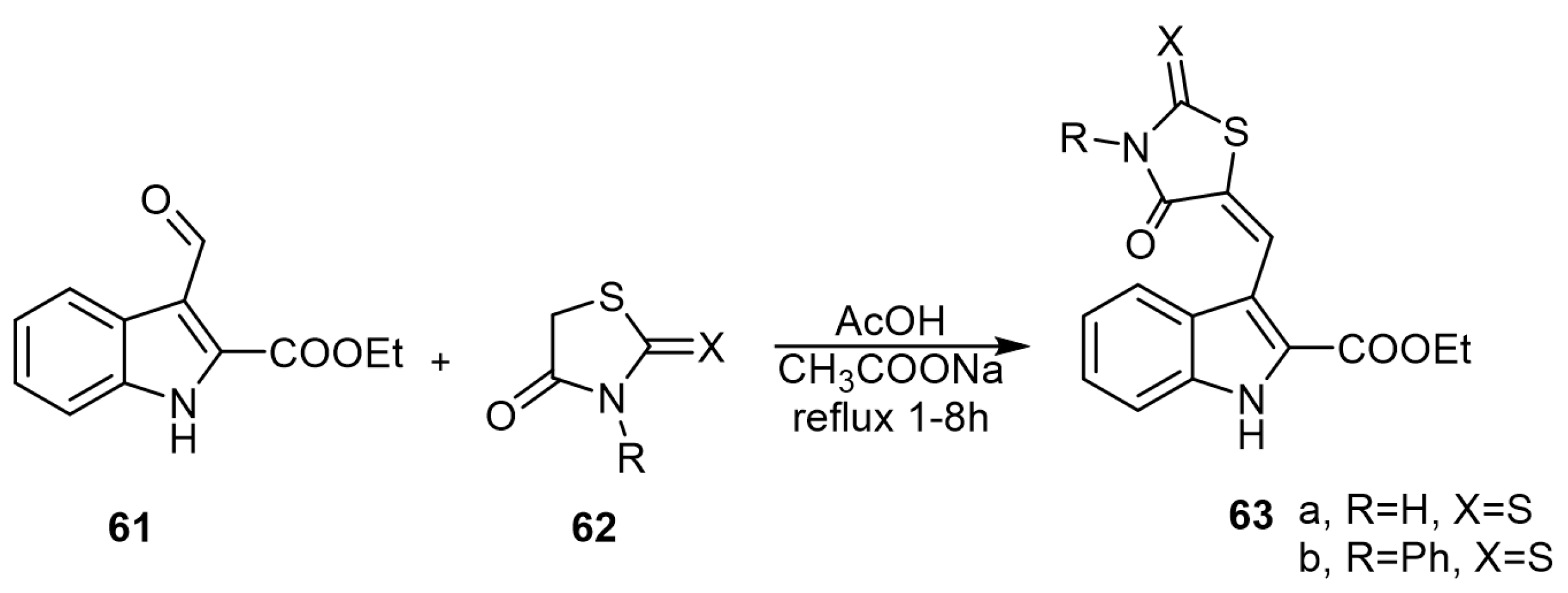


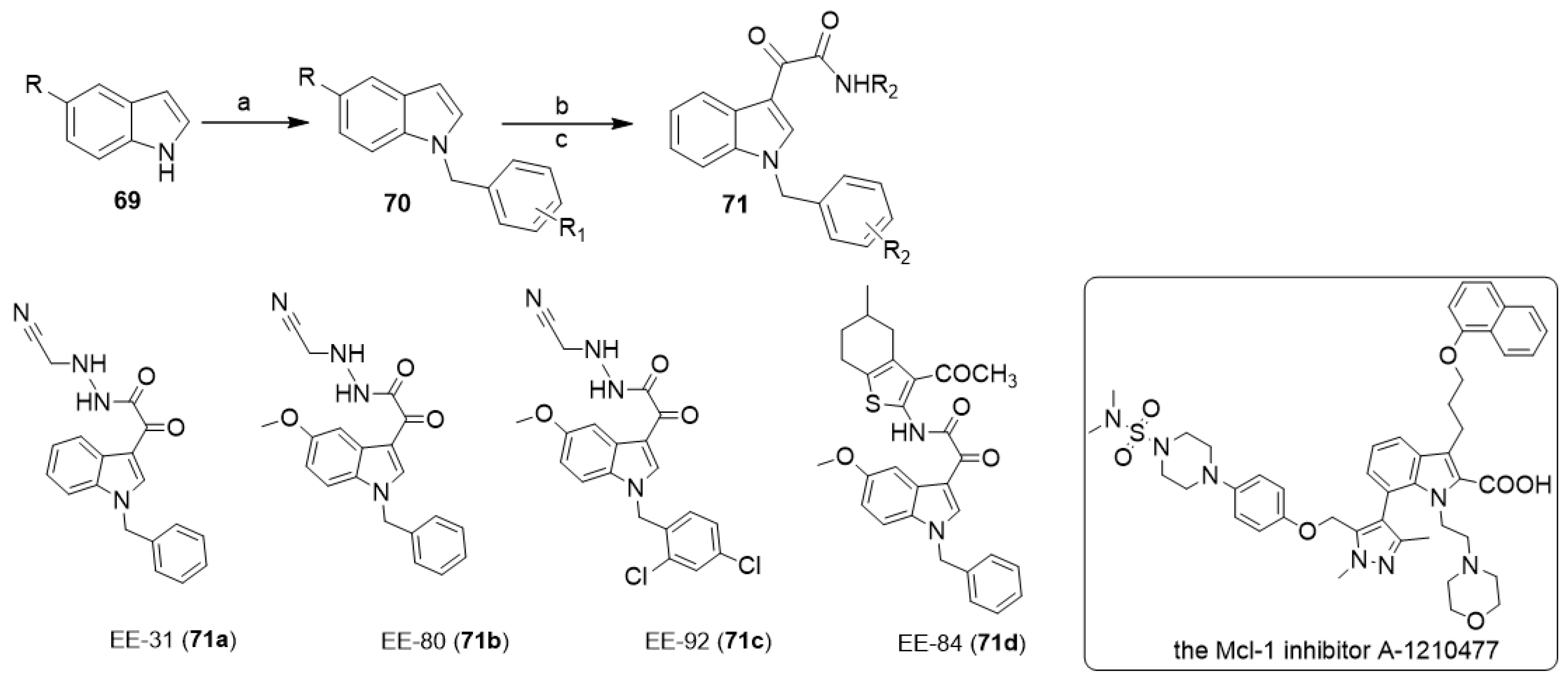
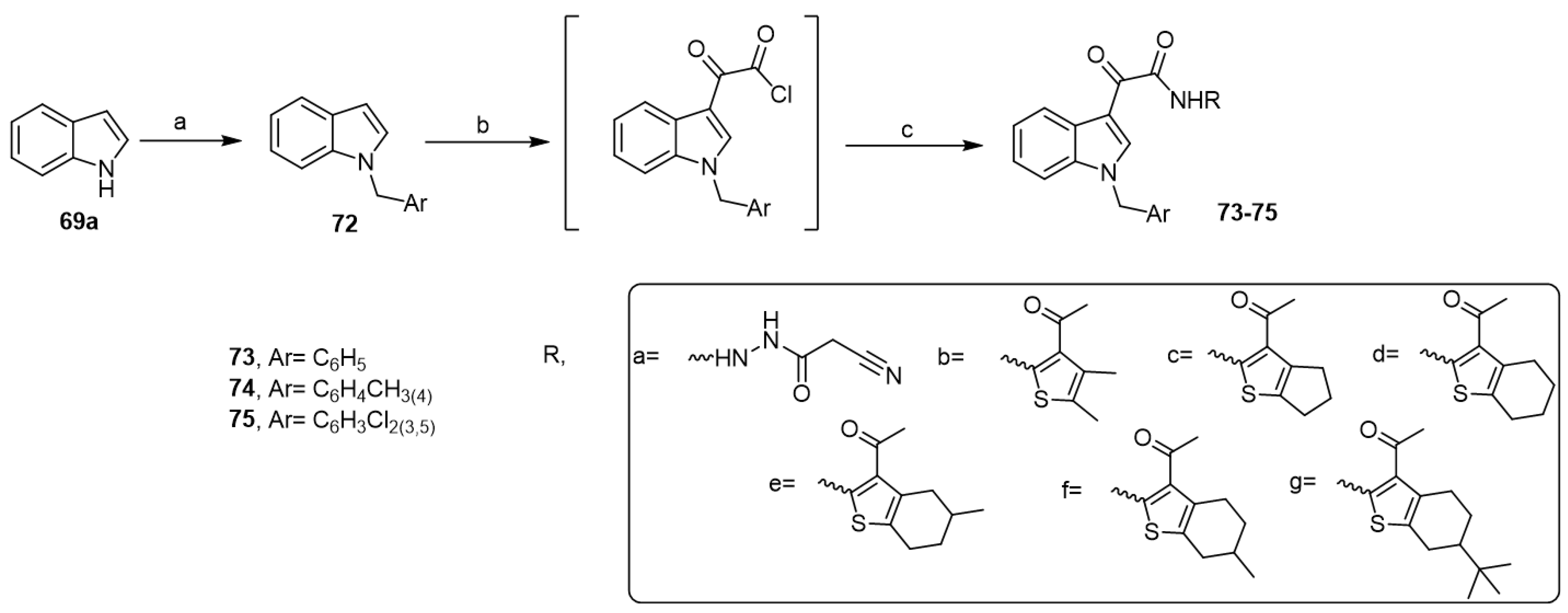
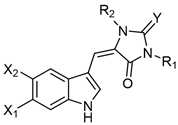 | ||||||
| Aplysinopsin Derivatives | X1 | X2 | R1 | R2 | Y | Source [Ref.] |
| Aplysinopsin (1) | H | H | Me | Me | NH | Thorecta sp. sponge Great Barrier Reef Australia [3], Verongia spengelli sponge Florida Keys [4], Dercitus sp. sponge Caribbean [5], Smenospongia aurea sponge Caribbean [24], Astroides calycularis anthozoan Mediterranean [25], Tubastraea aurea Japan scleractinian coral [11], Tubastraea sp. scleractinian coral Philippines [12], Radianthus kuekenthali sea anemone Japan [26], Aplysina sp. sponge Japan [27], Tubastraea faulkneri scleractinian coral Australia [13], Tubastraea sp. scleractinian Japane [14], Smenospongia sp. sponge Indo-Pacific reefs [8], and Verongula rigida sponge Florida Keys [9]. |
| Isoaplysinopsin (2) | H | H | H | Me | NMe | Aplysina sp. sponge Japan [27] and Smenospongia aurea sponge Jamaica [7]. |
| 2′-de-N-methylaplysinopsin (3) | H | H | H | Me | H | Dercitus sp. sponge Caribbean [5], Tubastrea coccinea coral Hawaii [10], Phestilla melanobrachia mollusk [10], Dendrophyllia sp. scleractinian coral Philippines [12], Smenospongia aurea sponge Jamaica [7], Verongula rigida sponge Florida Keys [9]. |
| Methylaplysinopsin (4) | H | H | Me | Me | NMe | Aplysinopsis reticulata sponge Australia [2] and Smenospongia aurea sponge Jamaica [7]. |
| 4′-Demethyl-3′-N-methylaplysinopsin (5) | H | H | Me | H | NMe | Dendrophyllia sp. scleractinian coral Philippines [12] and Smenospongia aurea sponge Jamaica [7]. |
| N-3′-ethyl-aplysinopsin (6) | H | H | Me | Et | NMe | Smenospongia aurea sponge Jamaica [7]. |
| 3′-Deimino-2′,4′-bis(demethyl)-3′-oxo-aplysinopsin (7) | H | H | H | H | O | Leptopsammia pruvoti scleractinian coral France [12]. |
| 3′-Deimino-3′oxoaplysinopsin (8) | H | H | Me | Me | O | Thorecta sp. sponge Great Barrier Reef Australia [3] and Tubastraea sp. scleractinian coral Philippines [12]. |
| 6-Bromo-2′-de-N-methylaplysinopsin (9) | Br | H | Me | H | NH | Dercitus sp. sponge Caribbean [5], Tubastrea coccinea coral Hawaii [10], Phestilla melanobrachia mollusk [10], Dendrophyllia sp. scleractinian coral Philippines [12], Tubastraea faulkneri scleractinian coral Australia [13], Smenospongia aurea sponge Jamaica [7], Hyrtios erecta sponge Japan [6]. |
| 6-Bromoaplysinopsin (10) | Br | H | Me | Me | NH | Tubastrea coccinea coral Hawaii [10], Smenospongia aurea sponge Caribbean [24], Astroides calycularis anthozoan Mediterranean [25], Radianthus kuekenthali sea anemone Japan [26], Tubastraea faulkneri scleractinian coral Australia [13], Smenospongia aurea sponge Jamaica [7], Smenospongia aurea sponge Florida Keys [9]. |
| 6-Bromo-4′-de-N-methylaplysinopsin (11) | Br | H | H | Me | NH | Smenospongia aurea sponge Caribbean [24]. |
| 6-Bromo-4′-demethyl- 3′-N-methyl-aplysinopsin (12) | Br | H | H | Me | NMe | Dendrophyllia sp. scleractinian coral Philippines [12]. |
| 5,6-Dibromo-2′-demethylaplysinopsin (13) | Br | Br | Me | H | NH | Hyrtios erecta sponge Japan [6]. |
| 6-Bromo-3′-deimino-2′,4′-bis(demethyl)-3′- Oxoaplysinopsin (14) | Br | H | H | H | O | Smenospongia aurea sponge Caribbean [28] and Leptopsammia pruvoti scleractinian coral France [12]. |
| 6-Bromo-3′-deimino-3′-oxoaplysinopsin (15) | Br | H | Me | Me | O | Astroides calycularis anthozoan Mediterranean [25] and Tubastraea sp. scleractinian coral Philippines [12]. |
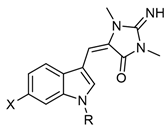 | |||
| Aplysinopsin Derivatives | X | R | Sources [Ref.] |
| N-propionylaplysinopsin (16) | H | OCCH2CH3 | Astroides calycularis anthozoan Mediterranean [25]. |
| 6-Bromo-N-propionylaplysinopsin (17) | Br | OCCH2CH3 | |
| N-methylaplysinopsin (18) | H | CH3 | Aplysina sp. sponge Japan [27]. |
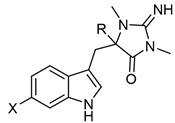 | |||
| Aplysinopsin Derivatives | R | X | Sources [Ref.] |
| 1′,8-Dihydroaplysinopsin (19) | H | H | Tubastrea coccinea coral Hawaii [10], Radianthus kuekenthali sea anemone Japan [26], and Thorectandra sp. sponge Indo-Pacific reefs [8]. |
| 6-Bromo-1′,8-dihydroaplysinopsin (20) | Br | H | |
| 6-Bromo-1-hydroxy-1′,8-dihydroaplysinopsin (21) | Br | OH | Thorectandra sp. sponge Indo-Pacific reefs [8]. |
| 6-Bromo-1-methoxy-1′,8-dihydroaplysinopsin (22) | Br | OCH3 | |
| 6-Bromo-1-ethoxy-1′,8-dihydroaplysinopsin (23) | Br | OCH2CH3 | |
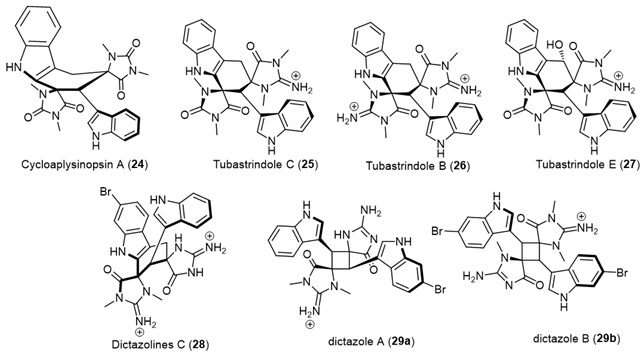 | |
| Aplysinopsin Dimers | Sources [Ref.] |
| Cycloaplysinopsin (24) | Scleractinian corals of the family Dendrophylliidae from Comoro islands and hard coral Tubastraea sp., from the Great Hanish in the Archipelago of the Hanish Islands, Yemen, tropical Indo-Pacific (Comoros, Philippines) scleractinian corals of the family Dendrophylliidae [29,30]. |
| Tubastrindoles A–C (25) | Stony Coral, Tubastraea sp. scleractinian Japane [14]. |
| Tubastrindole B (26) | Australian Marine Sponge, a specimen of the sponge Ianthella cf. flabelliformis [31]. |
| Tubastrindoles D–H (27) | Stony Coral, Tubastraea aurea Odomari area, Kagoshima Prefecture, Japan [32]. |
| Dictazolines A and B | Marine Sponge Smenospongia cerebriformis, Hospital Point on Solarte Isle, Boca del Toro, on the northwest coast of Panama [33]. |
| Dictazolines C–E (28) and Dictazoles A and B (29) | Marine Sponge Smenospongia cerebriformis, Panamanian sponge [34]. |
| Aplysinopsin Derivatives | Activity [Ref.] |
|---|---|
| Aplysinopsin (1) | - CNS permeable scaffold for dual inhibition of cholinesterase and BACE-1 inhibition [21,47]. - Possess monoamine oxidase (MAO) inhibitory activity (IC50 of 5.6 nM) [19]. - Antiplasmodial activity (IC50: 0.43 µg/mL) [48]. - Antineoplastic activity (IC50 values against L-1210 and KB cells, respectively, 2.3 and 6.4 µg/mL [4,27]. - Inhibit the growth of Staphylococcus epidermidis [8]. - An inhibitor of development of fertilized sea urchin eggs at 2.5 µg/mL [11]. - Induce symbiosis between sea anemone and anemonefish [26]. |
| Isoaplysinopsin (2) | - Showed cytotoxic against murine lymphoma L-1210 (IC50 11.5 µg/mL) and human epidermoid carcinoma KJ3 (31% inhibition at 20 µg/mL) cells [27]. |
| Methylaplysinopsin (4) | - Antidepressant activity by enhancing serotonin activity in the central nervous system [49,50]. - Inhibition of monoamine oxidase (MAO) [50]. - Showed cytotoxicity (IC50 values against L-1210 and KB cells of 3.5 and 6.7 µg/mL, respectively) [27]. |
| N-3′-ethyl-aplysinopsin (6) | - Serotonin receptors modulator with Ki value 1.7 µM to the 5-HT2A and 3.5 µM to 5-HT2C serotonin subtypes [7]. |
| 6-Bromo-2′-de-N-methylaplysinopsin (9) | - Serotonin receptors modulator (showed significant selectivity to the 5-HT2C serotonin subtype over the 5-HT2A subtype) [7]. - Antiplasmodial. - Inhibitor of nitric oxide synthase (nNOS). |
| 6-Bromoaplysinopsin (10) | - Serotonin receptors modulator (showed highest affinity to 5-HT2C with a Ki value similar to that of serotonin 0.33 µM) [7]. |
| 5,6-Dibromo-2′-demethylaplysinopsin (13) | - Inhibitor of nitric oxide synthase (nNOS) [6]. |
| 6-Bromo-3′-deimino-3′-oxoaply-sinopsin (15) | - Antiplasmodial activity [30]. |
| 1′,8-Dihydroaplysinopsin (19) | - Induce symbiosis between sea anemone and anemonefish [26]. |
| 6-Bromo-1′,8-dihydroaplysinopsin (20) 6-Bromo-1-hydroxy-1′,8-dihydroaplysinopsin (21) 6-Bromo-1-methoxy-1′,8-dihydroaplysinopsin (22) 6-Bromo-1-ethoxy-1′,8-dihydroaplysinopsin (23) | - Inhibit the growth of Staphylococcus epidermidis [8]. |
Disclaimer/Publisher’s Note: The statements, opinions and data contained in all publications are solely those of the individual author(s) and contributor(s) and not of MDPI and/or the editor(s). MDPI and/or the editor(s) disclaim responsibility for any injury to people or property resulting from any ideas, methods, instructions or products referred to in the content. |
© 2023 by the authors. Licensee MDPI, Basel, Switzerland. This article is an open access article distributed under the terms and conditions of the Creative Commons Attribution (CC BY) license (https://creativecommons.org/licenses/by/4.0/).
Share and Cite
El-Sawy, E.R.; Kirsch, G. An Overview of Aplysinopsins: Synthesis and Biological Activities. Mar. Drugs 2023, 21, 268. https://doi.org/10.3390/md21050268
El-Sawy ER, Kirsch G. An Overview of Aplysinopsins: Synthesis and Biological Activities. Marine Drugs. 2023; 21(5):268. https://doi.org/10.3390/md21050268
Chicago/Turabian StyleEl-Sawy, Eslam R., and Gilbert Kirsch. 2023. "An Overview of Aplysinopsins: Synthesis and Biological Activities" Marine Drugs 21, no. 5: 268. https://doi.org/10.3390/md21050268
APA StyleEl-Sawy, E. R., & Kirsch, G. (2023). An Overview of Aplysinopsins: Synthesis and Biological Activities. Marine Drugs, 21(5), 268. https://doi.org/10.3390/md21050268






